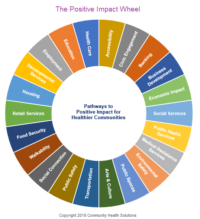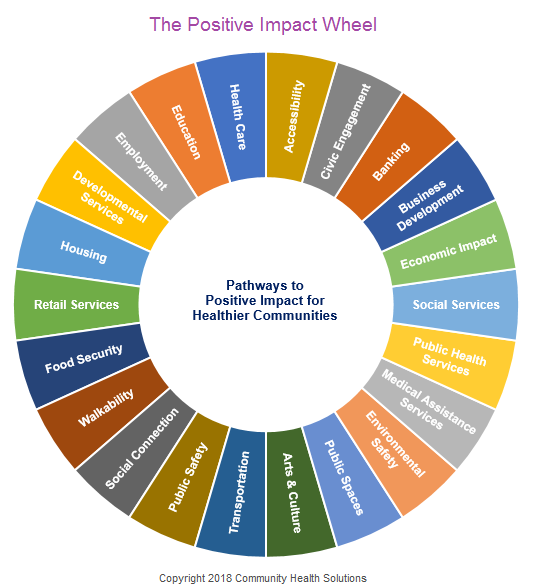 Health equity has emerged a core value for public policy and community health improvement. A key strategy for advancing health equity is to create health opportunity in partnership with the people we serve. Health opportunity has tremendous potential as a mobilizing strategy because virtually every organization can play a role in creating health opportunity. Here we provide a quick strategy guide for creating health opportunity by design.
Health equity has emerged a core value for public policy and community health improvement. A key strategy for advancing health equity is to create health opportunity in partnership with the people we serve. Health opportunity has tremendous potential as a mobilizing strategy because virtually every organization can play a role in creating health opportunity. Here we provide a quick strategy guide for creating health opportunity by design.
1. Adopt Health Opportunity as a Strategic Aim
One way to define health equity is in terms of health outcomes, such as ‘attainment of the highest level of health for all people,’ as suggested Healthy People 2020. Another approach is to define health equity in terms of health opportunity, such as ‘everyone has the opportunity to attain their highest level of health,‘ as suggested by the American Public Health Association.
 We recommend using the health outcomes definition to inform the vision or goal for health equity, and using the health opportunity approach to create practical strategies for advancing health equity. In essence, we can help advance the goal of attaining of the highest level of health for all people by employing the strategy of creating health opportunity for the people we serve.
We recommend using the health outcomes definition to inform the vision or goal for health equity, and using the health opportunity approach to create practical strategies for advancing health equity. In essence, we can help advance the goal of attaining of the highest level of health for all people by employing the strategy of creating health opportunity for the people we serve.
Our rationale for this focus is that health opportunity can be influenced by many factors, including income, education, employment, natural and built environment, food security, social supports, housing, public safety, public health, transportation, access to health services, access to community services, and more. This means all kinds of organizations may have the potential to advance health equity by creating health opportunity, including organizations in business, community development, education, human services, public safety, recreation, and philanthropy in addition to health care and public health. To think more how your organization may be influencing health opportunity, click on the Positive Impact Wheel. Every service or support listed within the wheel can help advance health opportunity either directly or indirectly.
Considering this broad array of possibilities might make it easier to envision creating health opportunity as a strategic aim for your organization. In the following steps we outline how to consider health opportunity as you assess needs, design strategies, develop capacity, execute for results, and demonstrate positive impact.
2. Assess Needs
As you assess the needs of the people you serve, look for differences in health opportunity. Differences in health opportunity may rooted in differences in income, education, housing, economic opportunity, public safety, and other cultural and structural factors that can influence individual health and well-being. You can look for these factors in assessments of the people you currently serve, or as part of broader community health needs assessments. Even if you cannot fully analyze or quantify these factors, it is important to include them as lenses for understanding what people need, and how your organization might optimize its impact.
3. Design Strategies
Think of strategy as the set of actions you will take to accomplish your mission with the people you serve. Then ask: What are the differences in health opportunity for the people we serve? How can we focus our work to help create health opportunity? Ask these two questions whenever you are making decisions about strategy for the organization as a whole, or for specific programs and services. Listen and learn from the perspective of your team and the people you serve. Also consider promising practices from other organizations that might fit your structure and culture.
4. Develop Capacity
Developing capacity means developing your people, practices, processes, policies, systems, and spaces for strategy execution. Start by assuring that your team is fully aware and informed about the organizational focus on creating health opportunity. Then engage the team in aligning practices, processes, etc. to achieve your intended results. This focus on team capacity building is too often overlooked and emphasizing this work on the front end can prevent a host of problems with execution.
5. Execute for Results
Think of execution as the daily practice of putting your strategy into action. How can we be sure that people are making decisions and taking action in ways that advance health opportunity for the people we serve? We can start by observing, listening, and measuring to learn what is working well, and where things are falling short. When challenges arise, we can systematically consider how people, practices, processes, policies, systems, and spaces could be better aligned. We can also remove obstacles that keep people from doing their best work.
6. Demonstrate Positive Impact
By adopting a health opportunity lens to guide your work, you should be able to demonstrate how your organization is creating positive impact in support of health equity. A good starting point for demonstrating positive impact is to simply describe how your organization advances health opportunity through your daily work. Remember here that you are supporting health opportunity whenever you are helping people improve their income, education, employment, environment, housing, transportation, public safety, nutrition, physical activity, access to health services, and access to community services. You can also add value by collaborating with others to improve health opportunity. When organizations are willing to work together for health opportunity, great things can happen!


